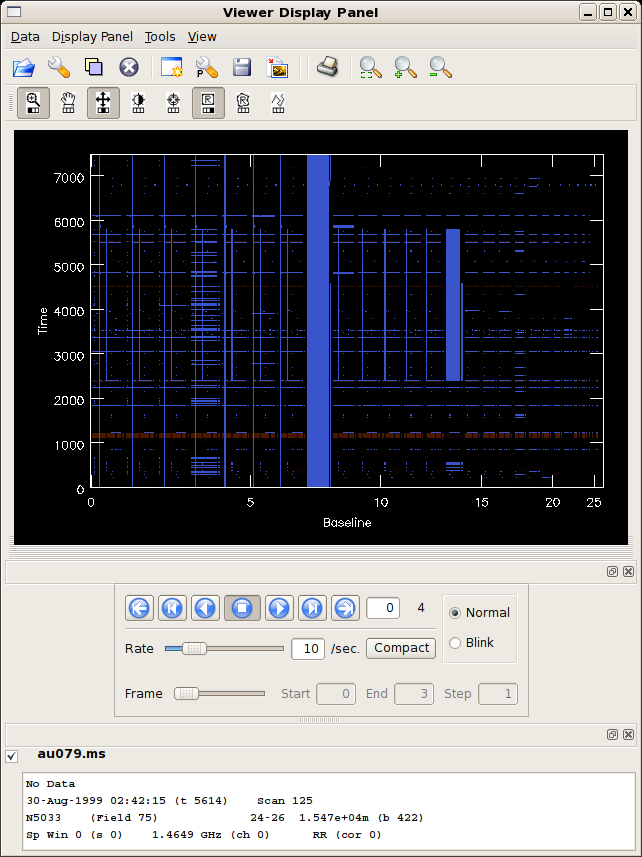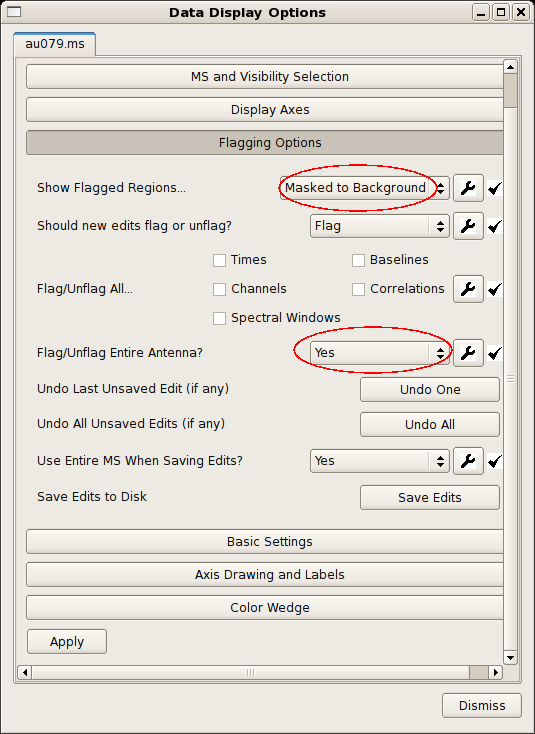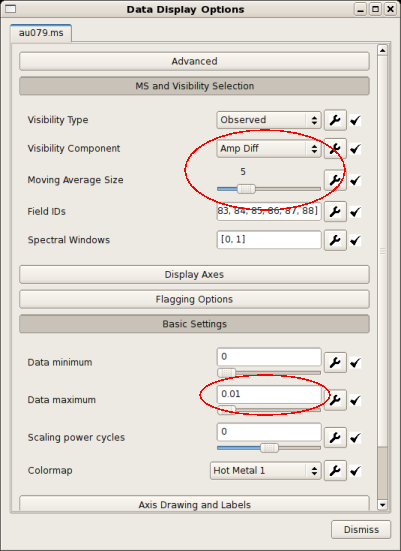Data flagging with viewer: Difference between revisions
| Line 73: | Line 73: | ||
<div style="float: left; width: 50%; align: left; vertical-align=middle;"> | <div style="float: left; width: 50%; align: left; vertical-align=middle;"> | ||
There is a choice of data to display. Select the '''MS and Visibility Selection''' tab on the '''Data Display Options''' window. The '''Visibility Component''' menu allows you to choose to display visibility data from the following list. | There is a choice of data to display. Select the '''MS and Visibility Selection''' tab on the '''Data Display Options''' window; see the figure at right. The '''Visibility Component''' menu allows you to choose to display visibility data from the following list. | ||
* Amplitude | * Amplitude | ||
* Phase | * Phase | ||
| Line 85: | Line 85: | ||
The rolling time windows needed to calculate the '''Diff''' and '''RMS''' options are tuned using the '''Moving Average Size''' slider. | The rolling time windows needed to calculate the '''Diff''' and '''RMS''' options are tuned using the '''Moving Average Size''' slider. | ||
All of these options are useful to investigate aberrant data, but '''Amp Diff''' can be particularly efficient. | All of these options are useful to investigate aberrant data, but '''Amp Diff''' can be particularly efficient. Reasonable options are shown in the figure at right. Be sure to turn down the display maximum ('''Data Maximum''' under '''Basic Settings''') to bring out the fainter variations. | ||
Revision as of 15:29, 24 November 2009
Overview
Your data will inevitably have some bad data. Perhaps a receiver on a given antenna is acting up, or perhaps the pointing on a given antenna is poor, and these problematic data will translate to (hopefully) obviously aberrant data in your measurement set. It's a good idea to inspect your data carefully before calibration and imaging, and CASA offers several tools to flag bad data interactively.
This tutorial illustrates how to use viewer to flag poor data. It will use the dataset AU079 from the VLA archive; this dataset is also used in the Imaging Flanking Fields tutorial.
Loading the Measurement Set into Viewer
As described in the Imaging Flanking Fields tutorial, the data may be loaded into CASA using the importvla command. The following commands import the data into the measurement set au079.ms and send them to the viewer.
# from loaddata.py
from glob import glob
# Define the list of files for reading. Use glob to perform wildcard matching with VLA archive filenames.
fileList = glob('AU079_*.xp?')
importvla(archivefiles=fileList,vis='au079.ms')
viewer('au079.ms') # load the data into the viewer for editing
The viewer command can also be invoked without argument, in which case a file selector GUI will appear.
Setting Up for Antenna-based Flagging
|
The figure at right shows the default viewer display for a measurement set. The axes are (y) time and (x) baseline, or antenna pair, enumerated by the common antenna number of the pair. Flagged data are highlighted in pale blue. Another window, titled Data Display Options, will also appear, allowing you to alter the display and flagging options. |
|
The blue highlights can be initially distracting, and they can be optionally suppressed by altering the Flagging Options in the Data Display Options. The figure at right shows the options.
In anticipation of the antenna-based editing to come, it's also worth setting the antenna flag.
Now, when multiple baselines are selected, all baselines to the common antenna will be flagged. |
|
There is a choice of data to display. Select the MS and Visibility Selection tab on the Data Display Options window; see the figure at right. The Visibility Component menu allows you to choose to display visibility data from the following list.
The rolling time windows needed to calculate the Diff and RMS options are tuned using the Moving Average Size slider. All of these options are useful to investigate aberrant data, but Amp Diff can be particularly efficient. Reasonable options are shown in the figure at right. Be sure to turn down the display maximum (Data Maximum under Basic Settings) to bring out the fainter variations.
|
--Jgallimo 19:14, 23 November 2009 (UTC)


